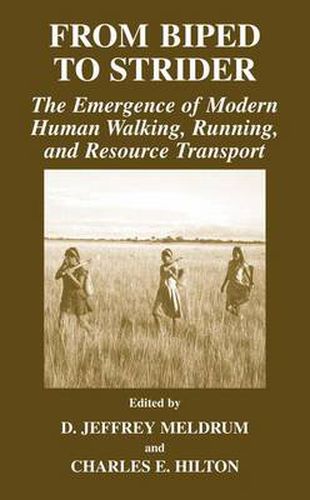Readings Newsletter
Become a Readings Member to make your shopping experience even easier.
Sign in or sign up for free!
You’re not far away from qualifying for FREE standard shipping within Australia
You’ve qualified for FREE standard shipping within Australia
The cart is loading…






This title is printed to order. This book may have been self-published. If so, we cannot guarantee the quality of the content. In the main most books will have gone through the editing process however some may not. We therefore suggest that you be aware of this before ordering this book. If in doubt check either the author or publisher’s details as we are unable to accept any returns unless they are faulty. Please contact us if you have any questions.
The study of human bipedalism has been overshadowed by many polarized debates. One dispute concerns whether or not australopithecines were wholly terrestrial or retained a degree of arboreality. Another deliberation focuses on the bipedalism of australopithecines compared to modern humans: was it similar, intermediate in nature, or unique? Because of the preoccupation with discussions such as these, the significant fact that modern human walking is more than locomotion on two legs has been underemphasized. This volume focuses on the pattern and process of the transition to the modern form of human locomotion, with its adaptations for a striding stiff-legged gait, efficiency of running, and economy of resource transport. This emerging group of contributors spanning the fields of anthropology, biology and anatomy debate issues such as: - When and in what sequence did these morphological traits appear? - What were the changes in the bio-behavioral complex of hominin locomotor evolution? - What were the implications for the enhancement and expansion of hominin mobility? This essential reading will be of interest to biological, paleontological, and physical anthropologists and students in these fields. ‘This is the book I have been waiting for. Community Operational Research has shown that analysis can be used not only for, but also with, community groups, helping them to gain more control of their situations. What Midgley and Ochoa-Arias’ volume does is provide not only rich examples of grass-roots practice, but also thought-provoking theoretical explorations. The editors have a point of view, but they allow space for debate with those who interpret Community OR differently.‘ Jonathan Rosenhead (Emeritus Professor of Operational Research, London School of Economics and Political Science; Ex-President of the Operational Research Society) ’.What the many authors in this book have in common is a commitment to serve the interests of all those affected by a community’s behavior - its stakeholders. This is acquiring a new significance as we decreasingly conceptualize corporations and organizations in general as organisms, and begin to think of them, as Charles Handy has, as communities.‘ Russell Ackoff (Professor Emeritus of the Wharton Business School, University of Pennsylvania; Ex-President of ORSA; Vice President of TIMS)
$9.00 standard shipping within Australia
FREE standard shipping within Australia for orders over $100.00
Express & International shipping calculated at checkout
This title is printed to order. This book may have been self-published. If so, we cannot guarantee the quality of the content. In the main most books will have gone through the editing process however some may not. We therefore suggest that you be aware of this before ordering this book. If in doubt check either the author or publisher’s details as we are unable to accept any returns unless they are faulty. Please contact us if you have any questions.
The study of human bipedalism has been overshadowed by many polarized debates. One dispute concerns whether or not australopithecines were wholly terrestrial or retained a degree of arboreality. Another deliberation focuses on the bipedalism of australopithecines compared to modern humans: was it similar, intermediate in nature, or unique? Because of the preoccupation with discussions such as these, the significant fact that modern human walking is more than locomotion on two legs has been underemphasized. This volume focuses on the pattern and process of the transition to the modern form of human locomotion, with its adaptations for a striding stiff-legged gait, efficiency of running, and economy of resource transport. This emerging group of contributors spanning the fields of anthropology, biology and anatomy debate issues such as: - When and in what sequence did these morphological traits appear? - What were the changes in the bio-behavioral complex of hominin locomotor evolution? - What were the implications for the enhancement and expansion of hominin mobility? This essential reading will be of interest to biological, paleontological, and physical anthropologists and students in these fields. ‘This is the book I have been waiting for. Community Operational Research has shown that analysis can be used not only for, but also with, community groups, helping them to gain more control of their situations. What Midgley and Ochoa-Arias’ volume does is provide not only rich examples of grass-roots practice, but also thought-provoking theoretical explorations. The editors have a point of view, but they allow space for debate with those who interpret Community OR differently.‘ Jonathan Rosenhead (Emeritus Professor of Operational Research, London School of Economics and Political Science; Ex-President of the Operational Research Society) ’.What the many authors in this book have in common is a commitment to serve the interests of all those affected by a community’s behavior - its stakeholders. This is acquiring a new significance as we decreasingly conceptualize corporations and organizations in general as organisms, and begin to think of them, as Charles Handy has, as communities.‘ Russell Ackoff (Professor Emeritus of the Wharton Business School, University of Pennsylvania; Ex-President of ORSA; Vice President of TIMS)